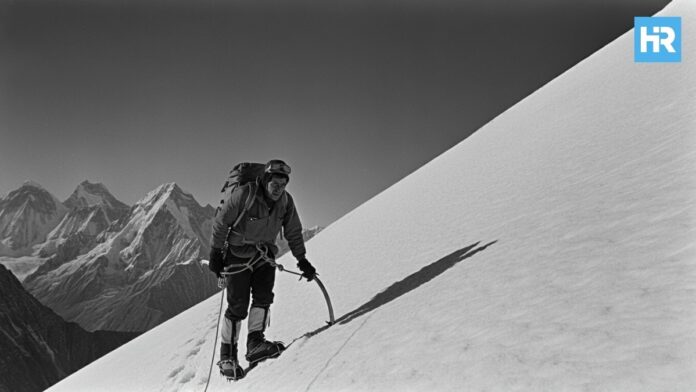Mountaineering, often called alpinism, is the adventure of climbing mountains.
It combines hiking, rock climbing, and ice climbing, requiring immense physical strength, skill, and the ability to handle tough conditions.
Climbers face challenges like avalanches, crevasses, high altitudes, and changing weather.
They use special equipment such as ropes, crampons, ice axes, and harnesses to make their climbs safer and more efficient.
Over centuries, mountaineering has grown from a way to survive or explore into an exciting sport and hobby.
It is driven by the human need to explore, challenge ourselves, and experience the beauty of nature.
This guide takes you through the rich history of mountaineering, its milestones, and the people who have shaped this thrilling pursuit.
- In the early days, people climbed mountains for survival, religion, or science. It later became a sport, starting with the first climb of Mont Blanc in 1786, which inspired others to climb for fun and adventure.
- Inventions like crampons, stronger ropes, and better ice axes in the 1900s made climbing easier and safer. These tools allowed climbers to tackle tougher and steeper mountains.
- The tallest mountains, like Everest, became the biggest goal for climbers. In 1953, Edmund Hillary and Tenzing Norgay climbed Mount Everest, inspiring people worldwide to chase their dreams.
Early Beginnings of Mountaineering
Mountaineering began long ago when people climbed mountains for practical reasons like hunting, trading, or finding shelter.
Early climbs were usually not for fun but had purposes such as religion or science.
One of the first known mountain climbs was in 1492, when Antoine de Ville, under the command of King Charles VIII of France, climbed Mont Aiguille.
They used ladders and ropes to scale the “inaccessible mountain.”
The climbers hoped to find gods at the top but instead found a meadow filled with flowers.
They stayed for six days, held a Mass, and left three crosses behind.
This climb was an early example of mountaineering done for reasons beyond necessity.
The Birth of Recreational Mountaineering
By the 18th century, people in Europe began to see mountains as places of beauty and adventure instead of danger.
The Alps, in particular, became a focus of interest.
In 1760, a scientist named Horace-Bénédict de Saussure was amazed by Mont Blanc, the tallest mountain in Europe (15,771 feet or 4,807 meters).
He offered a reward to anyone who could climb it.
This challenge was finally met in 1786 when Dr. Michel-Gabriel Paccard and Jacques Balmat reached the summit of Mont Blanc.
And de Saussure himself climbed it the following year.
As you can expect, these achievements inspired more people to climb mountains for the thrill and accomplishment.
In the early 19th century, climbing the Alps became a popular activity.
In 1818, climbers reached the summit of Aiguille du Midi, and by 1823, Chamonix had a professional guiding service to help climbers.
Mountaineering was becoming more organized and accessible, which set the stage for the sport’s golden age.
The Golden Age of Mountaineering
The “Golden Age of Mountaineering” happened between 1854 and 1865, and it was called this as it was a time when climbers scaled most of the major peaks in the Alps.
British adventurers, often with the help of Swiss and French guides, led many of these expeditions.
Major Achievements
- 1854: Alfred Wills climbed the Wetterhorn, sparking wide interest in climbing for sport.
- 1865: Edward Whymper made the first ascent of the Matterhorn, but the climb ended tragically when five climbers died during the descent.
The Alpine Club and Women in Mountaineering
In 1857, the Alpine Club of Great Britain was founded as the world’s first mountaineering club.
It provided climbers with resources and support, which made climbing safer and more organized.
During this time, women also began participating in mountaineering.
In 1871, Lucy Walker became the first woman to climb the Matterhorn.
In 1874, Meta Brevoort made the first winter ascent of the Jungfrau, showing that women could achieve great things in mountaineering and inspiring others to follow.
Technological Advancements in Mountaineering
By the late 19th century, climbers sought new challenges and developed better tools and techniques.
These improvements made climbing safer and allowed them to take on tougher routes.
- 1908: Oscar Eckenstein created 10-point crampons, which made ice climbing faster and easier by reducing the need to cut steps into the ice.
- 1920s: Bolts became widely used as safety anchors for climbing rocky surfaces.
- Ice Axes: Eckenstein also improved the design of ice axes, allowing climbers to use them with one hand for better control.
Techniques like rappelling (descending with a rope) and belaying (securing the climber with a rope) became standard practice so climbers could then tackle more difficult climbs.
Mountaineering Expands Beyond Europe
After climbing many of Europe’s tallest mountains, climbers began looking to other parts of the world for new challenges and bigger peaks to explore.
South America
In 1802, Alexander von Humboldt attempted to climb Chimborazo in the Andes, reaching almost 20,000 feet.
He was among the first to connect altitude sickness to a lack of oxygen.
In 1880, Edward Whymper successfully summited Chimborazo, and in 1897, Matthias Zurbriggen climbed Aconcagua (22,831 feet), the highest peak in the Western Hemisphere.
North America
Climbing in North America began with peaks like Pikes Peak in the 1820s, but the completion of the Canadian Pacific Railway in 1885 opened up the Rockies and Selkirk Mountains to more climbers.
Remarkable climbs included:
- 1890: Mount Sir Donald was summited.
- 1894: Mount Temple was climbed.
- 1913: Denali (Mount McKinley), the tallest peak in North America at 20,310 feet, was successfully climbed.
Africa and Asia
Mount Kilimanjaro (19,341 feet) in Africa was summited in 1889, followed by Mount Kenya (17,058 feet) in 1899.
In New Zealand, climbers reached the top of Aoraki/Mount Cook in 1894.
The Challenge of the Himalayas
The Himalayas, home to the world’s tallest peaks, represented the ultimate test for climbers.
These mountains offered unmatched challenges in height, weather, and terrain.
Early Attempts
In 1922, George Finch and Geoffrey Bruce made history by reaching 27,250 feet on Mount Everest using bottled oxygen, a groundbreaking achievement at the time.
In 1950, a French team climbed Annapurna I (26,545 feet), the first 8,000-meter peak to be summited.
The Everest Success
The most famous achievement in mountaineering came on May 29, 1953, when Edmund Hillary of New Zealand and Sherpa Tenzing Norgay reached the summit of Mount Everest (29,035 feet).
This historic climb captured the world’s imagination and remains one of the greatest moments in mountaineering.
Other Himalayan successes followed, including the first ascents of K2 in 1954 and Cho Oyu in 1956.
By 1964, all of the world’s 8,000-meter peaks had been climbed.
Modern Mountaineering and Cultural Changes
After World War II, mountaineering became more popular and open to everyone, not just experienced climbers.
The Ladies’ Alpine Club, started in 1907, helped women get involved in mountaineering and opened the sport to a wider group of people.
In the 1980s, climbers began taking on the Seven Summits challenge, which involves climbing the tallest mountain on each continent.
This became a famous goal for climbers all over the world and a way to push their limits.
Important Achievements
- 1992: Junko Tabei became the first woman to complete the Seven Summits, inspiring climbers everywhere with her success.
- 2019: Nirmal Purja set a record by climbing all 14 of the world’s 8,000-meter peaks in just over six months, an amazing show of strength and skill.
Today, mountaineering continues to grow, with new challenges and opportunities for people from all walks of life.
Technological Advances in Modern Mountaineering
Without question, modern mountaineering has greatly benefited from technological advancements.
New equipment has made climbing safer and easier, with stronger ropes, better tools, and lighter gear widely available.
Key improvements include:
- Clothing: Modern climbers benefit from breathable, waterproof, and insulated fabrics that help regulate body temperature in extreme weather. Lightweight, layered clothing systems keep climbers warm in cold conditions and cool during strenuous climbs. These fabrics also dry quickly, reducing the risk of hypothermia.
- Equipment: Lightweight ropes, stronger harnesses, and crampons with better grip make climbing less physically demanding and much safer. Modern carabiners and safety anchors are designed to handle more weight and stress, giving climbers extra security on steep or icy terrain. Ice axes are now more ergonomic, providing a better grip and making them easier to handle in harsh conditions.
- Base Camps: Popular mountains like Mount Everest now have well-equipped base camps with medical facilities, food supplies, and trained staff. These camps allow climbers to rest, acclimatize to high altitudes, and prepare for summit attempts. Portable heating systems and lightweight tents have also improved comfort during long expeditions.
- Communication Devices: Satellite phones, GPS trackers, and portable radios connect climbers with their teams and rescue services. These devices have drastically improved safety by allowing climbers to call for help quickly in emergencies. Some trackers even share real-time locations, making search and rescue efforts more efficient.
- Navigation Tools: Advanced GPS systems and detailed maps help climbers more accurately navigate remote areas. Modern altimeters and weather apps give climbers real-time data about their elevation and conditions, helping them make better decisions during their ascent.
- Oxygen Systems: Refined oxygen cylinders are now lighter and more efficient, allowing climbers to reach extreme altitudes with less strain. These systems are critical for scaling peaks over 8,000 meters, where thin air can be life-threatening.
Ethical and Environmental Challenges
As mountaineering becomes more popular, it faces important challenges affecting the environment and climbers’ safety.
Famous peaks like Mount Everest are often overcrowded, with many climbers attempting to summit simultaneously.
This overcrowding increases the risk of accidents and puts pressure on the mountain’s fragile environment.
A big concern is the waste left behind by climbers, including discarded gear, trash, and even human waste, which pollutes these natural areas.
This issue has become so serious that some mountains are now called “the world’s highest garbage dumps.”
Another problem is the number of inexperienced climbers taking on difficult climbs without proper training.
And as new climbers often rely heavily on guides, they’re putting themselves and their guides in danger.
Rescue missions in remote and extreme environments are risky and can sometimes result in further injuries or loss of life.
Thus, the mountaineering community faces an ongoing challenge of balancing the thrill of adventure with the need to protect nature.
Efforts are being made to address these problems, such as stricter regulations, mandatory clean-up initiatives, and encouraging climbers to follow the principle of “leave no trace.”
The future of mountaineering depends on finding sustainable ways to enjoy the mountains while protecting their beauty for generations to come.
The Everlasting Spirit of Mountaineering
Mountaineering has grown from its early days of survival and exploration into a popular sport and adventure for people worldwide.
It shows the human drive to challenge limits, achieve great things, and enjoy the beauty of nature.
From the first climbs of Mont Blanc to the tallest peaks in the Himalayas, mountaineering has been shaped by courage, skill, and determination.
New technology and better safety measures have made climbing more accessible, but it still requires training, preparation, and respect for the mountains.
At the same time, the growing number of climbers has brought challenges like overcrowding and environmental harm, reminding us to climb responsibly.
Mountaineering is a story of strength, teamwork, and the desire to reach new heights.
As people continue to take on new climbs, the mountains will remain a source of adventure and inspiration for years to come.






